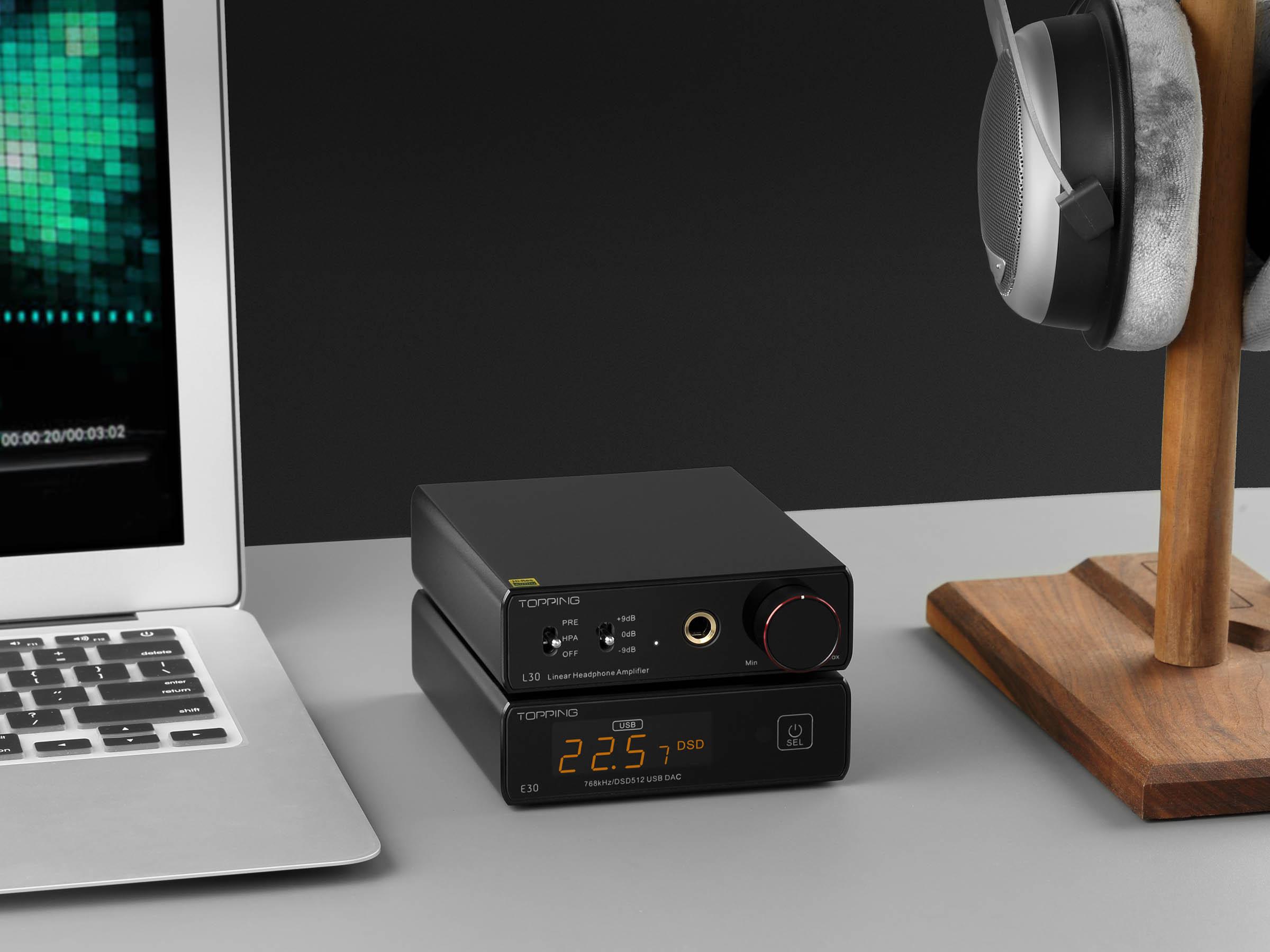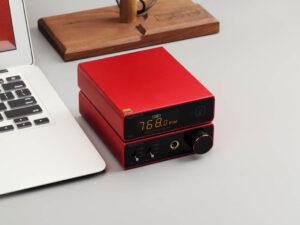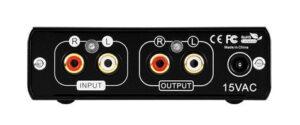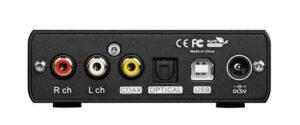

As I said in my review of the Sony WH-1000XM4 wireless headphone, my listening habits are changing. That wireless headphone was the impetus I needed to finally break free from wires when listening on the go via my iPhone. But if I'm kicking back for some serious music therapy at home and my wife is asleep or working, or I simply need to fully shut out the rest of the world, there's just no replacement—for me, at least—for a good open-backed set of cans and a dedicated headphone amp. Something like the Topping L30 and its accompanying digital-to-analog converter, the E30.

Sure, many of the electronics I own have headphone jacks. Some of them, like the one built into my beloved Peachtree Audio integrated amp, are actually pretty great. But the fact of the matter is that I don't really feel like firing up my two-channel listening system just to plug in a set of headphones. Eleven times out of ten, when I strap on a personal listening device, I'm not going to load up a CD or SACD or DVD-A. Instead, I'm going straight to Qobuz or Spotify to load up a playlist or radio station so I can close my eyes and get lost in the music without having to fiddle with input selection or even track selection.
I'm not claiming that's representative of how most audio enthusiasts use their headphones at home. In fact, I'm sure that anecdote is downright infuriating to most audiophiles. But the beauty of our hobby is that there's an appropriate product for everyone's tastes, everyone's needs, everyone's habits. And just speaking purely for myself here, something like the Topping L30 and E30 combo offers the perfect mix of convenience, performance, and ergonomics.
The duo, by the way, comes to us on loan from Apos, a US-based online retailer dedicated to curating headphone and headphone-related products, offering helpful buying advice, and assembling what it refers to as "Ensembles"—premade DAC/HPA systems that are also accompanied by headphone recommendations.
 The Apos TOPPING-30 Ensemble includes the E30 and the L30 together with a Fanmusic C003 stereo RCA interconnect, and at $300.99 the package represents a reasonable savings over purchasing the components separately. Individually, the E30 and L30 sell for $149.99 each and the Fanmusic C003 runs $35.99. So, by buying the ensemble, you're effectively getting the interconnect for a buck and a penny. Or you could look at it as a 10.4-percent discount on the whole kit and caboodle. Either way, it's a great deal, and Apos has a price-match guarantee on the off-chance you find the Topping gear and Fanmusic interconnect cheaper somewhere else.
The Apos TOPPING-30 Ensemble includes the E30 and the L30 together with a Fanmusic C003 stereo RCA interconnect, and at $300.99 the package represents a reasonable savings over purchasing the components separately. Individually, the E30 and L30 sell for $149.99 each and the Fanmusic C003 runs $35.99. So, by buying the ensemble, you're effectively getting the interconnect for a buck and a penny. Or you could look at it as a 10.4-percent discount on the whole kit and caboodle. Either way, it's a great deal, and Apos has a price-match guarantee on the off-chance you find the Topping gear and Fanmusic interconnect cheaper somewhere else.
The Topping E30 is built on AKM's AK4493EQ two-channel DAC chip and features USB-B, coaxial, and optical digital inputs. The USB input supports DSD 64-512, and PCM at sampling rates up to 768kHz and word lengths up to 32-bit, whereas the coax and optical inputs max out DoP (DSD over PCM) up to quad rate and 192kHz PCM.
The L30 employs what Topping refers to as a NFCA (Nested Feedback Composite Amplifier) design for compatibility with low-impedance headphones (down to an insane 8 ohms, allegedly), but its three-way gain selection switch means that it's perfectly suited for use with practically any headphone, from the most power-hungry cans to the most sensitive in-ear monitors. It features stereo RCA inputs as well as outputs, meaning it can function as a preamp or a headphone amp that delivers 3,500mW per channel into 16 ohms; 2,300mW per channel into 32 ohms; and 280mW per channel into 300 ohms, all with rated THD+N of less than 0.1 percent.
The simplicity to which I referred above extends not only to operation, but also to setup. The E30 and L30 don't feature a ton of inputs, so there's really not much to worry about in that respect. The only real aggravation in terms of physical configuration is the fact that the soft plastic caps covering the RCA connections require roughly as much force and finesse to remove as do a hippo's wisdom teeth. I ended up having to use pliers.
Other than that, everything is as straightforward as could be, although I did have to tinker around with setup just a bit to achieve optimal performance. The E30 DAC can be powered by its USB connection, so my first inclination was simply to plug it into the USB output of my Maingear media PC and route the RCA outputs to the inputs of the L30. A bit of listening, though, convinced me that I needed to opt for a cleaner power source.
 Thankfully, the DAC also sports a 5v DC input, but the power cord it comes with terminates in a USB-A connection, so I had to borrow a USB power adapter from my iPhone. With that plugged into my SurgeX surge eliminator and power conditioner, the audio cleaned up quite nicely. The difference wasn't substantial, mind you, but enough to be noticeable when listening via my Westone custom IEMs.
Thankfully, the DAC also sports a 5v DC input, but the power cord it comes with terminates in a USB-A connection, so I had to borrow a USB power adapter from my iPhone. With that plugged into my SurgeX surge eliminator and power conditioner, the audio cleaned up quite nicely. The difference wasn't substantial, mind you, but enough to be noticeable when listening via my Westone custom IEMs.
The E30 doesn't have much by way of controls. A simple multi-function button on the front allows you to wake the DAC from standby and switch it between DAC and Preamp modes. If you opt for the latter, you'll need to use the included remote for volume control. But I left it in DAC mode since I intended to use it only with the L30. You'll also need the remote if you want to tweak the PCM and DSD filters, or to select between three display-brightness presets.
The L30 features just a few more controls, but not many. The front face features a pair of Schiit-like dipswitches that control power and mode (Off/HPA/Preamp) and gain (-9dB/0dB/+9dB), along with a nice rotary volume control. Between those sits the quarter-inch headphone jack, and that's it.
Unlike the E30, the L30 comes with an AC adapter brick, and it's worth noting that it weighs approximately as much as one of its masonry namesakes. It's also worth noting that it's of the wall-wart variety, with the prongs built into the brick itself, something to consider if you're using a power strip or UPS whose receptacles are rotated 90 degrees from the norm.
At any rate, with just a bit of rearranging of power cords to give the L30's brick the coveted end spot, I had the entire system out of the box and up and running within five minutes. As I said above, my only source was my Maingear PC, and almost all of my listening was done via Spotify (using DirectSound) and Qobuz (in WASAPI exclusive mode). I did experiment a little with different headphones just to test the stack's capabilities, but the vast majority of my critical listening was done via my Audeze LCD-2 open-back cans—one of Apos' headphone recommendations for this system.
I started my listening, as I almost always do with any headphone-related product, with Allman Brother's Band's "Blue Sky" via Qobuz, not because of its audiophile bona fides, but because of my familiarity with it. Dicker with the tonal balance even slightly or introduce any appreciable amount of coloration, and I'm going to hear it with this track way before I would pick up on it while listening to Snooty McSnooterbritches' Concerto for Bagpipes and Kazoo in C half-sharp minor, Op. Whatever.
What I heard coming out of the Topping stack was… well, it was "Blue Sky," exactly as it exists in my brain, with all of the little squawks caused by fingers sliding across nickel strings, all of the saturated valve-amp harmonics, all of the little nuanced textured created by Butch and Jaimoe's syncopated drumming—all of those little details that I know are there to be extracted by a good DAC were presented and accounted for, flowing from the stack effortlessly.
Next up I took Steely Dan's "My Old School" for a spin, mostly to test the stack's imaging and stereo separation. There really isn't much to say in that department. I didn't hear the slightest cause for concern. What struck me, though, is just how dynamic the Topping gear is, especially for this price and when paired with this headphone. Transient response was also excellent, and I was particularly impressed by the attack of the horns and percussion. For such an itty-bitty stack, this duo packs a hell of a punch.
That same capacity for dynamic punch also revealed itself with "The Throne Room and End Title" from John Williams' recently remastered score for Star Wars: A New Hope. Soundstaging and imaging were also excellent, but what I found myself focusing on most was the perfectly rendered textures and timbres of the horns and strings. There's a tactile quality to the output of the Topping stack that just draws me in. There's no editorializing here, no accentuation of this, that, or the other aspect of the music. But the low noise floor, excellent detail, and perfect tonal balance combine to create an experience that constantly reminds you you're listening to real instruments recorded in real rooms.
Lastly, I played back some tri-tone warbles (at 96kHz and 192 kHz) to test for intermodulation distortion. I found that most of the PCM filters did a good job of minimizing IMD, and what little remained was quiet enough to be masked by any music played at the same volume. So take heart, high-resolution audio enthusiasts: The Topping gear earns its Hi-Res Audio certification handily.
There's really only one thing I don't like about the Topping E30/L30 combo, and that's the fact that the E30's remote won't control the volume of the L30. There's a way to use the remote for volume control, but it means putting the E30 into preamp mode instead of DAC mode, which would not be my preference.
I also find it ever-so-slightly annoying that the remote has buttons that serve no function. It's understandable as a cost-savings measure, as this remote is used across the Topping DAC line, all the way up to the much pricier D90, but it's still a bit frustrating to look at the remote and think, "Wait, what does that button do again? Oh yeah, nothing."
Of the headphone setups that I have any appreciable experience with, the Topping gear probably compares most closely to Schiit's offerings. The L30 headphone amp sits right between the Schiit Magnius at $199 and the Magni at $99 and strikes a nice overall balance between their specs and capabilities. Or you could opt for something like the Vali at $149 if you're looking to add tube amplification to your headphone setup.
The E30, by contrast, is more comparable to the Modius DAC ($199) in its capabilities (and its DAC chip), although the Schiit piece does add AES inputs and balanced XLR outputs.
I could be wrong about this, but I think a barrier to entry into the dedicated headphone setup arena for a lot people is either price or hassle, which is what makes the Apos TOPPING-30 Ensemble such a compelling little setup. It delivers serious performance for a fraction of the price of many DAC/HPA combos, and its simple setup and operation make a pleasure to use. You don't get niceties that come with a much higher price, like balanced outputs, but it's up to you to decide how essential such upgrades are.
For me, this stack sits right in the sweet spot I'm looking to hit. It offers a substantial upgrade over the headphone outputs built into most of my gear and it'll actually drive the fussiest cans in my collection. For $300, it's pretty much a no-brainer.
Additional Resources
• Find more about Apos products at the Apos website.
• If you want more in-depth coverage of Headphone amps be sure to check out more reviews on Home Theater Review.
2021-03-14 19:19:04
We have two great rooms each 24' x 26' x 9' and another that is 27' x 28' x 10' . the smaller great room has a 65" and the larger has a 50" Samsung plasma. We are interested in placing 86" LG Nano-Cell 4K HDTV's or the new Vizio 85" in each room or go with a pair of 77" Sony's. Would appreciate any suggestions.